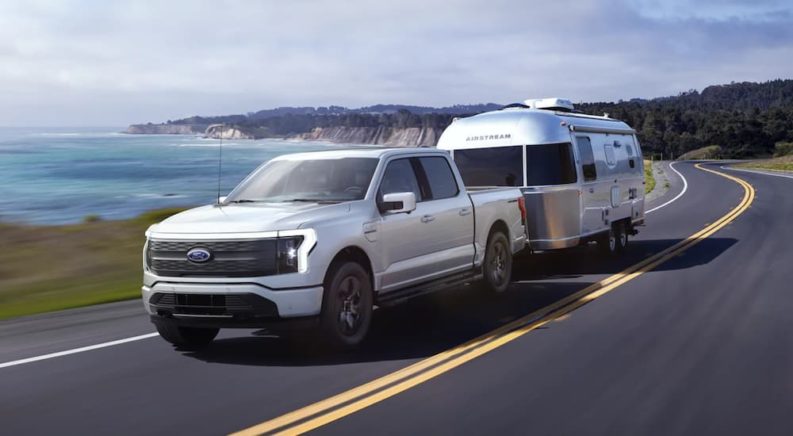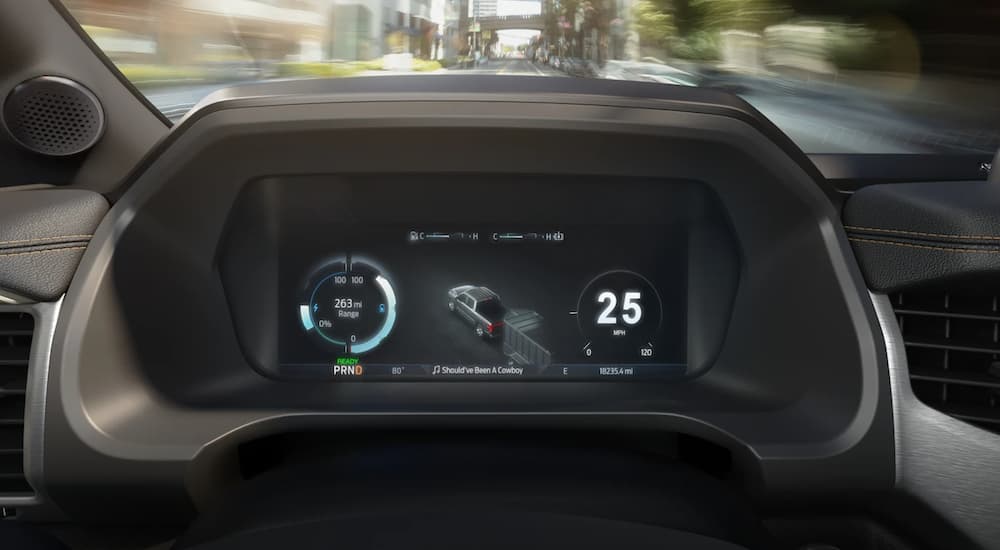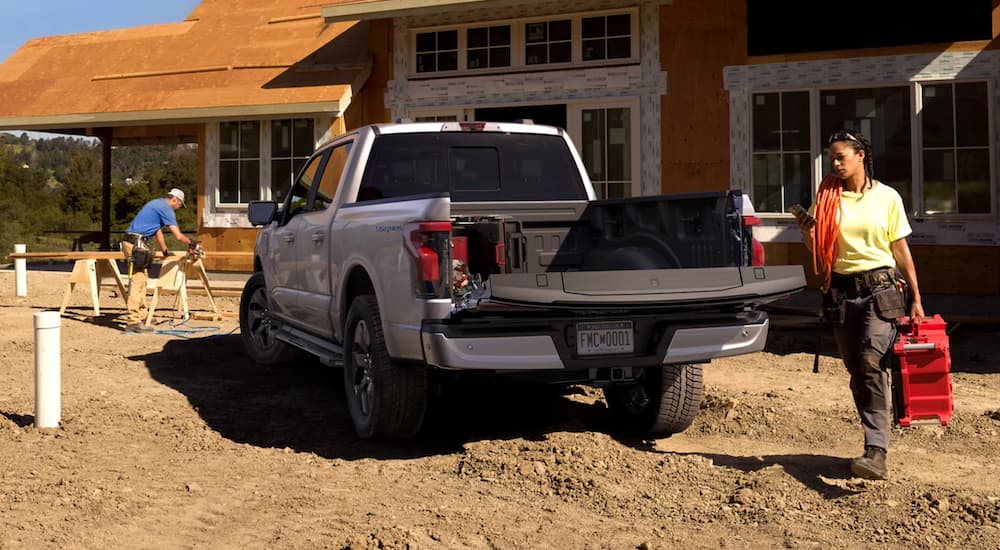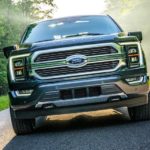“Lightning” is about as easy as it gets when naming an electric vehicle (speaking of which – any bets on whether Ford’s first electric sports car will be a Thunderbird?). It’s an especially obvious choice for an electric version of the F-150 pickup truck, which has included a “Lightning” model twice in the last 30 years, from 1993 – 1995 and 1999 – 2004. However, those trucks were powered by modified versions of the F-250 Super Duty’s V8 engines and were about the farthest thing from “fuel-efficient” as it gets. The all-new 2022 Ford F-150 Lightning is a different beast entirely, but despite its electric motors, it is the fastest Lightning yet.
The Spark of Inspiration
In the early ’90s, Chevy was delivering a different kind of truck. The 454 SS was a pickup capable of rushing from 0-60 mph in under 7.5 seconds – it was a muscle car in a truck body. With the truck wars already well underway, Ford’s target was clear. As the racing-oriented SVO unit transformed into the famous SVT (Special Vehicles Team), they chose Ford’s two most iconic vehicles to modify for their breakout effort: the Mustang (which gave us the Cobra and Cobra R) and the F-150. The outcome was the 1993 Ford F-150 Lightning, which featured a regular cab F-150 body with a slightly lowered stance, a distinctive body-color grille, signature wheels, and Lightning badging as all that visually separated it from its sibling.
But under the hood, it was a different story. Billed as a “Mustang GT with a cargo bed,” the Lightning featured a modified 5.8 L V8 with special cylinder heads derived from the GT40. The engine’s standard 200 hp and 300 lb-ft of torque were boosted to 240 hp and 340 lb-ft, impressive numbers for the day and good enough for a 7.2-second 0-60 mph time. That might not sound like much anymore, but the 1996 Mustang GT was only a touch quicker with a 6.6-second 0-60 mph time! A stiffer suspension all but eliminated body roll and a rumbling exhaust note continuously called to mind the Lightning’s fraternal twin.
But the Lightning was not a vehicle of compromises. Its 700 lb payload capacity and 5,000 lb towing limit matched that of the regular F-150, so despite being oriented towards driving performance and the muscle car experience, owners didn’t sacrifice an ounce of practicality to get it. The same can’t be said for the notoriously impractical Mustang sports coupe, so could one argue that the Lightning was actually a better performance vehicle than the Mustang Cobra? There are over 10,000 first-gen Lightning owners who would probably say it was!
Blink and You’ll Miss It
The first-gen Lightning moved nearly 12,000 units in three years, but with a major body change for the F-150 approaching, it was discontinued in 1995. It would be four years before another Lightning appeared in 1999, and while the SVT crew was still not interested in compromise, unlike the first go-around, the second-gen Lightning’s emphasis was now almost entirely placed on speed. The 5.4 L V8 engine was fitted with an Eaton supercharger to achieve an incredible power increase from the last generation, throwing down 360 hp and 440 lb-ft of torque. Once again, the Lightning featured signature but subtle appearance tweaks – a slightly lowered ride, a unique front fascia, and a step-side bed with flared fenders adding a significant cool factor to the millennium-era truck.
That wasn’t all, of course. With a mid-cycle engine upgrade and late-cycle capability upgrade, the second-gen Lightning could haul 1,340 lb payloads and tow 5,000 lb trailers thanks to a maximum of 380 hp and 450 lb-ft of torque. That made it the most powerful production vehicle in the United States! But most significantly, the 2001 – 2004 Ford F-150 Lightning could hoof it from 0-60 mph in as little as 5.2 seconds and earned itself a Guinness World Record for being the fastest production pickup in the world (top speed 147.7 mph).
Cool looks, a cool name, and serious street cred added up. Ford sold nearly 30,000 of the second-gen Lightning over six years, and they’ve held their value well. It was a shame that due to the continually increasing size of the F-150, Ford was unable to tune an 11th-gen model to the degree required to earn a third-gen Lightning badge. Instead, SVT turned their attention to the trails, giving us the legendary F-150 Raptor. As of 2005, the Ford Lightning sport truck was no more.
A Bolt from the Blue
Over the ensuing years, something changed in the automotive industry, a change driven by an upstart manufacturer committed to the production of competitively-priced mass-market electric vehicles. Charging infrastructure, range, and recharge times made enormous leaps, and commitments to lowered emissions have made electric vehicles more viable than ever. But nobody had yet dared to put an electric pickup truck on a sales lot – until now. This previously non-existent segment is suddenly crowded with upcoming vehicles like the Rivian R1T, Tesla Cybertruck, and GMC Hummer EV, and it is into this segment that Ford is inserting itself with an electric truck – the third-gen F-150 Lightning.
Oh no, here they go again – putting the name of something iconic and sporty onto something bland and tame, you might be tempted to groan. If the first thing that comes to mind when you think of “electric” is the Nissan Leaf, you might have a point, but then consider what the current standard for electric performance is. The electric Tesla Model S Plaid and Porsche Taycan Turbo are among the quickest production cars on the planet, thanks to instantaneous torque delivery. Not to be left behind, Ford is projecting 4×4 output of up to 563 hp and 775 lb-ft of torque from the 2022 F-150 Lightning’s dual electric motors. That’ll make the Lightning the most powerful F-150 by a huge margin, even out-powering many Super Duty models in the process!
With all that power, not only will the 2022 F-150 Lightning have the ability to handle 2,000 lb payloads and 10,000 lb trailers – Ford is projecting a 0-60 mph time in the four-second range, which would make this the quickest Ford truck ever by a significant margin. Of course, that means nothing if the range isn’t competitive, but Ford is projecting a rated range of 230 miles for the standard battery pack and 300 miles for the extended range pack – and those are expected to be conservative estimates. That’s because it’s suspected that Ford’s numbers are based on a 1,000 lb payload, which will inevitably eat into the range just as it does for a gas-powered truck. Unloaded, the 2022 Lightning could be one of the longest range electric production vehicles to date, in a package that has appeal to drivers all over the country!
The Lightning is expected to be competitively priced against the regular F-150, starting at just under $40,000. That will make the F-150 Lightning significantly more accessible than the $67,500 Rivian R1T or the $79,995 Hummer EV, on top of having brand recognition that’ll make die-hard truck drivers more likely to consider making the switch. The Lightning also provides three significant and interesting features that no other truck on the market today can provide: the frunk, Blue Cruise, and Ford Intelligent Backup Power.
First, the frunk (front trunk) – with no engine but the same massive engine bay, the Lightning will provide owners with a huge, secure, and waterproof storage area for their belongings, something that many regular pickup truck owners can only wish for. Second, Blue Cruise is Ford’s semi-autonomous driving software, already set up with over 100,000 miles of mapped roads allowing for genuine hands-free driving across the US and Canada.
Last but not least, there’s Ford Intelligent Backup Power enabled by the 80-amp Ford Charge Station Pro that Ford will help owners install in their garages. Whether you’re preparing for a power outage or looking to minimize your grid consumption during peak hours, your properly equipped F-150 Lightning can deliver up to 9.6 kW of power back to your home! Based on usage of 30 kWh per day, there’s enough juice to power your home for three days, but rationed usage could be stretched to well over a week during long-term outage scenarios. Add it all up, and the F-150 Lightning just might be the most useful pickup truck ever made.
A Legacy of Raising the Bar
Nearly 30 years after the release of the original F-150 Lightning muscle truck and 18 years after the discontinuation of what was once the fastest pickup on Earth, the Ford F-150 Lightning name is back in 2022. Yes, it’s an obvious name for an electric pickup, especially given the history that F-150 and the Lightning moniker already have. But it’s more than that. The 2022 Lightning will be every bit the performance truck that its predecessors were and gets back to its roots by sacrificing virtually none of the gas-powered F-150’s working capabilities to do it.
As if that isn’t enough, by going electric and integrating the best modern technology available, Ford is making this “niche” vehicle one of the most practical ever, with near-autonomous driving capability, secure “frunk” storage, and the ability to route power back to the home for days of backup electricity. This isn’t some “lifestyle” pickup like the distinctive but alienating Tesla Cybertruck or the exclusive Hummer EV super-truck. This is the everyday Ford F-150 electrified, and we are thunderstruck.






